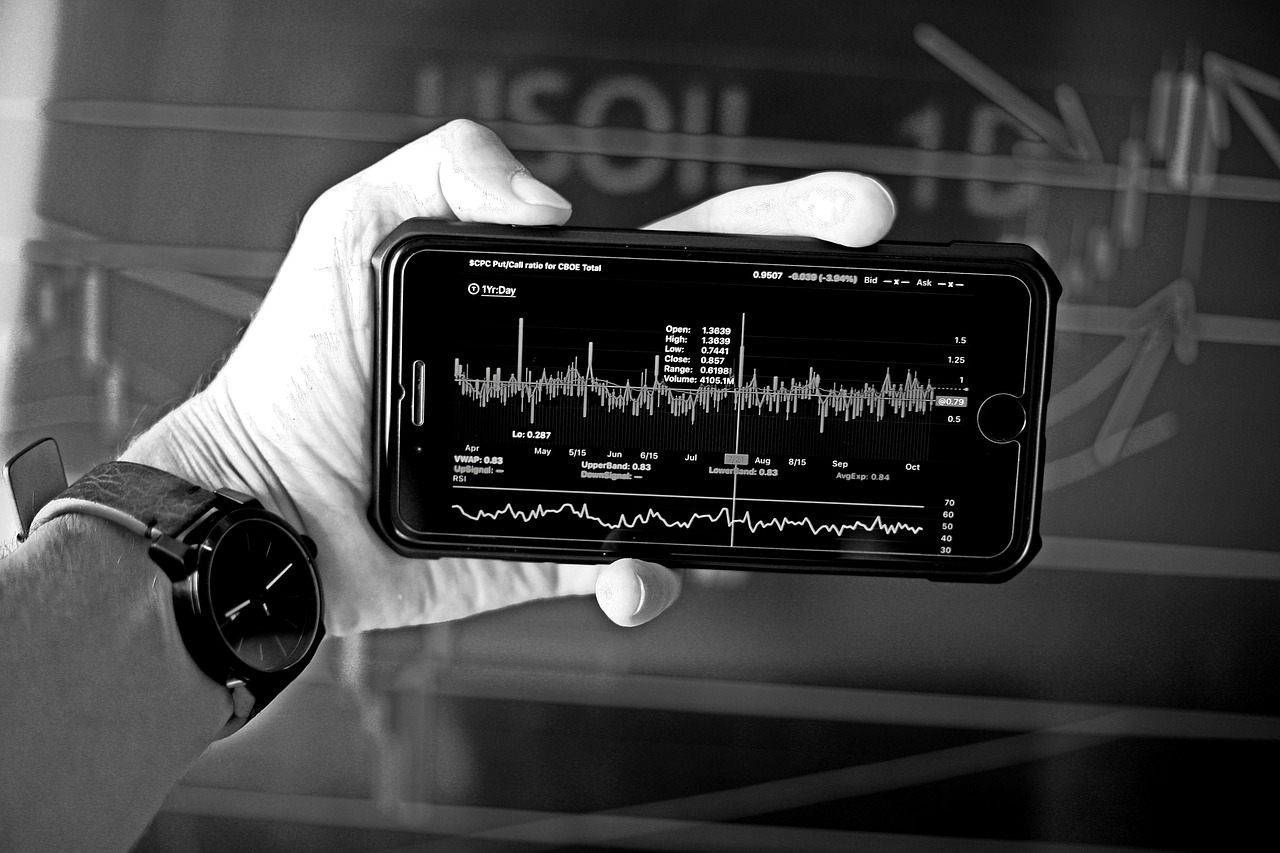How to Analyze Price Trends Using Historical Data
Analyzing price trends using historical data is like being a detective in the world of finance. It involves piecing together clues from the past to make educated guesses about the future. With the right tools and techniques, you can uncover hidden patterns that can guide your investment decisions and help you navigate the often turbulent waters of the market. Whether you’re a seasoned investor or just dipping your toes into the financial pool, understanding how to analyze price trends is essential for making informed choices that can lead to success.
Historical data is the bedrock of trend analysis. Think of it as the backstory of a character in a novel; it provides context and depth that inform the present. By examining past price movements, traders can establish benchmarks that illuminate current market conditions and offer insights into future predictions. This data can come from various sources, including stock exchanges, financial news outlets, and specialized data providers. It’s crucial to gather accurate and comprehensive data to ensure your analysis is grounded in reality.
When diving into price trends, it’s important to recognize the different types: upward, downward, and sideways. Each trend tells a story about market conditions and investor sentiment.
- Upward Trends: Characterized by rising prices, indicating strong demand and bullish sentiment.
- Downward Trends: Marked by falling prices, reflecting weak demand and bearish sentiment.
- Sideways Trends: Prices remain relatively stable, suggesting indecision among investors.
Understanding these trends helps investors adjust their strategies accordingly, whether they’re looking to buy, hold, or sell.
It’s essential to differentiate between short-term and long-term trends, as each requires distinct approaches and considerations. Short-term trends can offer quick opportunities for profit, while long-term trends provide insights into the overall market direction. Recognizing the difference is crucial for effective analysis.
Short-term trends often resemble the quick flashes of a firefly; they can be bright and captivating but are fleeting. Traders often rely on tools like moving averages and momentum indicators to capture these rapid movements. For instance, a simple moving average can smooth out price data to help identify the direction of the trend, while momentum indicators can signal when a trend is gaining strength or losing steam.
On the other hand, long-term trends are like the steady flow of a river. They provide a clearer picture of where the market is heading over time. By analyzing historical data over extended periods, investors can make strategic decisions based on sustained movements. This could involve looking at quarterly or yearly price trends, which can reveal underlying economic conditions and market cycles.
Technical indicators are essential tools in trend analysis. They help traders interpret price movements and forecast future trends through visual representations. Common indicators include:
- Moving Averages: These help smooth out price data to identify the direction of the trend.
- Relative Strength Index (RSI): This measures the speed and change of price movements to identify overbought or oversold conditions.
- Bollinger Bands: These provide a relative definition of high and low prices, helping traders identify potential reversals.
By combining these indicators with historical data, traders can enhance their analysis and improve their chances of making profitable trades.
Effective charting techniques allow for clear visualization of price trends, enabling analysts to identify patterns and make informed decisions based on historical data. Two popular chart types are:
Line charts provide a straightforward representation of price movements over time. They connect closing prices with a continuous line, making it easy to identify trends and changes in market direction. This simplicity is often appealing to new traders, as it presents data without overwhelming details.
Candlestick charts offer a more detailed view of price action. Each "candlestick" represents price movement within a specific time frame, revealing market sentiment and potential reversal points through their unique formations. The body of the candle indicates the opening and closing prices, while the wicks show the high and low prices during that time period. This rich visual data can help traders make more nuanced decisions.
Understanding market sentiment is vital for trend analysis, as it influences price movements and can signal potential changes in market direction. Sentiment can be gauged through various indicators and tools.
Sentiment indicators, such as the Fear and Greed Index, help gauge investor emotions and can provide valuable insights into potential market reversals. When fear dominates, prices may drop, creating buying opportunities; conversely, excessive greed can lead to overbought conditions.
News events can significantly impact price trends; analyzing historical reactions to news can enhance predictive capabilities and inform trading strategies. For example, an earnings report that surpasses expectations can lead to a surge in stock prices, while negative news can trigger sell-offs. By keeping an eye on news cycles, traders can better anticipate market movements.
Applying historical price trend analysis can lead to better investment decisions, risk management, and overall market understanding, ultimately improving trading performance. By leveraging the insights gained from historical data, traders can develop strategies that align with their financial goals.
Developing investment strategies based on historical price trends allows investors to capitalize on market movements and enhance their portfolio performance. For instance, using historical data to identify key support and resistance levels can guide entry and exit points in trades.
Effective risk management techniques, informed by historical data, help traders mitigate potential losses and protect their investments in volatile markets. Setting stop-loss orders based on historical price levels can safeguard against unexpected downturns, ensuring that losses are kept within acceptable limits.
Q1: What is the most important factor in analyzing price trends?
A: While many factors are important, understanding historical data is crucial as it provides context for current market conditions.
Q2: How can I start analyzing price trends?
A: Begin by gathering historical price data and familiarizing yourself with charting techniques and technical indicators.
Q3: Are there specific tools for analyzing trends?
A: Yes, there are many trading platforms and software that offer tools for technical analysis, including charting capabilities and indicators.

Understanding Historical Data
When it comes to analyzing price trends, historical data is your best friend. Think of it as the treasure map that guides you through the unpredictable landscape of financial markets. Without this data, you're essentially navigating in the dark, relying on gut feelings rather than facts. Historical data provides a wealth of information, showcasing how prices have moved over time, and it can be instrumental in forecasting future price behaviors.
At its core, historical data consists of past price points, trading volumes, and market conditions. This data allows investors and analysts to identify patterns and trends that can inform their decision-making processes. For instance, if you're looking at the stock market, you might analyze how a particular stock has performed over the past five years to predict its future trajectory. This is not just guesswork; it's based on solid evidence.
Moreover, historical data serves several important functions:
- Contextual Understanding: It provides context for current market conditions. By examining past trends, you can better understand what might happen next.
- Benchmarking: Historical data acts as a benchmark, allowing you to compare current prices against historical averages to assess whether an asset is overvalued or undervalued.
- Risk Assessment: By analyzing how prices have reacted to various market events in the past, you can gauge potential risks and prepare accordingly.
To illustrate the importance of historical data, let's consider a simple example. Imagine you're looking at a company's stock that has consistently risen in price over the last decade. If you only focus on the most recent quarter, you might miss the bigger picture of its long-term growth. Conversely, if the stock has been on a downward trend for several years, it could signal underlying issues that you need to be aware of before making an investment decision.
In essence, understanding historical data is not just about numbers; it's about storytelling. Each price point tells a story of market sentiment, economic conditions, and investor behavior. By piecing these stories together, you can gain a comprehensive understanding of how markets operate. This insight is invaluable, especially in an age where market dynamics can change in the blink of an eye.
As you delve deeper into historical data, remember to consider various sources. Financial news websites, investment platforms, and specialized data analytics tools can provide rich datasets for your analysis. The more comprehensive your data, the clearer the picture you can paint of the market's potential future movements.
In conclusion, historical data is the backbone of effective price trend analysis. It equips you with the knowledge necessary to make informed decisions, whether you’re a seasoned investor or just starting your journey in the financial world. So, next time you’re about to make a trading decision, take a moment to reflect on the stories that historical data has to tell—you might just find the insights you need to succeed.

Types of Price Trends
When it comes to analyzing price trends, understanding the different types is like having a roadmap to navigate the complexities of the financial market. Price trends can be broadly categorized into three main types: upward trends, downward trends, and sideways trends. Each type tells a unique story about market behavior and can significantly influence investment strategies.
An upward trend is characterized by rising prices over a specific period, indicating strong demand and positive sentiment among investors. Think of it as a rocket taking off; the momentum builds, and prices soar as more investors jump on board. In a bullish market, you might see consistent higher highs and higher lows, making it an ideal time for investors to consider entering positions.
Conversely, a downward trend reflects declining prices, often driven by negative news, poor earnings reports, or broader economic concerns. Picture a roller coaster going downhill—investors might panic and start selling off their assets, leading to further declines. Identifying a downward trend early can help traders cut losses or even short-sell to capitalize on the downward momentum.
Lastly, we have the sideways trend, where prices move within a horizontal range, indicating a period of consolidation. This is akin to a calm before the storm; market participants are unsure about the future direction, leading to indecisiveness. During this phase, prices neither rise nor fall significantly, which can present opportunities for traders to buy low and sell high within the established range.
Understanding these price trends is crucial for any investor. By recognizing whether the market is in an upward, downward, or sideways trend, investors can tailor their strategies accordingly. For instance, during an upward trend, one might focus on buying and holding assets, while in a downward trend, short-selling could become a more viable strategy. Sideways trends might encourage traders to engage in range trading, where they buy at support levels and sell at resistance levels.
To further illustrate the differences between these trends, let's take a look at the following table:
| Type of Trend | Characteristics | Investor Strategy |
|---|---|---|
| Upward Trend | Prices consistently rising, higher highs and lows. | Buy and hold; capitalize on upward momentum. |
| Downward Trend | Prices consistently falling, lower highs and lows. | Short-sell or cut losses; protect investments. |
| Sideways Trend | Prices moving within a horizontal range. | Range trading; buy low, sell high. |
In conclusion, recognizing the type of price trend is fundamental to making informed investment decisions. Each trend presents unique opportunities and challenges, and understanding how to navigate them can significantly enhance your trading performance. So, whether you're a seasoned investor or just starting, keep a keen eye on these trends—they could be your ticket to successful trading.

Short-term vs. Long-term Trends
When it comes to analyzing price trends, understanding the difference between short-term and long-term trends is crucial. Think of it like driving a car: short-term trends are your quick reactions to immediate changes in the road, while long-term trends are akin to your overall route planning. Each timeframe requires distinct approaches and considerations, and recognizing these differences can significantly impact your trading success.
Short-term trends typically span days to weeks and are often influenced by immediate market events, such as earnings reports or economic data releases. Traders focusing on these trends often utilize tools like moving averages and momentum indicators to identify quick opportunities for profit. For instance, if a stock price suddenly spikes due to positive news, a short-term trader might jump in to capitalize on that momentum. However, these trends can be volatile and require constant monitoring, making them a double-edged sword.
On the other hand, long-term trends can span months or even years, providing a broader perspective on market direction. Investors looking at long-term trends are less concerned with daily fluctuations and more focused on the overall trajectory of an asset. This approach often involves fundamental analysis, where factors like company performance, economic conditions, and industry trends come into play. For example, a long-term investor might notice that a particular sector is steadily gaining traction, prompting them to adjust their portfolio accordingly.
To help illustrate the differences between short-term and long-term trends, consider the following table:
| Aspect | Short-term Trends | Long-term Trends |
|---|---|---|
| Timeframe | Days to Weeks | Months to Years |
| Focus | Immediate Market Events | Overall Market Direction |
| Tools Used | Moving Averages, Momentum Indicators | Fundamental Analysis, Economic Indicators |
| Risk Level | Higher Volatility | Lower Volatility |
In conclusion, whether you’re a short-term trader or a long-term investor, understanding these trends is essential for making informed decisions. By recognizing the unique characteristics of each, you can tailor your strategies to fit your financial goals. So, are you ready to take control of your trading journey and harness the power of both short-term and long-term trends?
- What is a short-term trend? A short-term trend refers to price movements that occur over a brief period, typically days to weeks.
- How can I identify long-term trends? Long-term trends can be identified through fundamental analysis and by observing price movements over months or years.
- What tools are best for analyzing short-term trends? Tools like moving averages and momentum indicators are commonly used for short-term trend analysis.
- Why is it important to differentiate between short-term and long-term trends? Understanding the difference allows traders and investors to tailor their strategies effectively, aligning with their financial goals.

Identifying Short-term Trends
When it comes to investing, short-term trends can be your best friend, offering quick opportunities for profit that can be seized before they vanish. But how do you actually identify these fleeting trends? Well, it’s all about having the right tools and a keen eye for detail. Think of it like hunting for treasure; you need a map (your data) and a compass (your indicators) to guide you to the gold. One of the most effective ways to pinpoint short-term trends is by using moving averages. These averages smooth out price data over a specific period, allowing you to see the general direction of the market without getting bogged down by daily fluctuations.
For instance, if you’re looking at a 10-day moving average, you're essentially filtering out the noise of daily price changes, giving you a clearer picture of the trend. When the price crosses above the moving average, it could indicate a potential upward trend, while a drop below might suggest a downward trend. It’s like watching the tide; you can see the waves (price movements) but understanding the tide (trend) is what helps you make informed decisions.
Another crucial tool in your arsenal is the momentum indicator. This measures the speed of price changes and can help you identify whether a trend is gaining strength or losing steam. Imagine you’re at a racetrack; if a car is speeding up, it's likely to continue moving fast for a while. Similarly, if the momentum indicator shows increasing strength, it could be a sign that the trend will continue in the same direction. Conversely, if the momentum begins to wane, it might be time to reassess your position.
Additionally, keeping an eye on volume is essential. Volume indicates how many units of a security are being traded and can provide insights into the strength of a trend. A rising price accompanied by increasing volume suggests strong buyer interest, while a rising price with low volume might indicate a lack of conviction in that trend. It’s like trying to lift a heavy weight; if you have a strong team (high volume) to help you, you’re more likely to succeed than if you’re going it alone (low volume).
To sum it all up, identifying short-term trends is about combining various tools and indicators to get a comprehensive view of the market. By leveraging moving averages, momentum indicators, and volume analysis, you can navigate the choppy waters of the market with greater confidence. Just remember, trends can change quickly, so always be ready to adapt your strategy!
- What is a short-term trend? A short-term trend typically refers to price movements that occur over a period of days to weeks, allowing traders to capitalize on quick price changes.
- How do moving averages help in identifying trends? Moving averages smooth out price data, helping traders identify the overall direction of a market by filtering out daily fluctuations.
- What role does volume play in trend analysis? Volume indicates the strength of a price movement; higher volume suggests strong interest in a trend, while low volume may indicate a lack of conviction.
- Can short-term trends change quickly? Yes, short-term trends can change rapidly due to market news, economic data, or shifts in investor sentiment, requiring traders to stay alert.

Recognizing Long-term Trends
When it comes to investing, recognizing long-term trends is akin to reading the roadmap of a vast and winding journey. These trends don’t just pop up overnight; they develop over time, shaped by a myriad of factors including economic indicators, political events, and shifts in consumer behavior. By understanding long-term trends, investors can make informed decisions that align with the overall market direction, rather than getting caught up in the noise of short-term fluctuations.
One of the key aspects of recognizing long-term trends is to analyze price movements over extended periods, typically looking at data spanning months or even years. This approach helps investors to filter out the daily volatility that can often cloud judgment. For instance, a stock might appear to be in a downward spiral over a few weeks, but when viewed on a longer timeline, it may reveal a steady upward trajectory. Such insights can be crucial for making strategic investment decisions.
To effectively identify long-term trends, investors can utilize various methods and tools:
- Moving Averages: By calculating the average price over a specific period, moving averages smooth out price data to highlight the trend direction. For example, a 200-day moving average can provide a clear picture of the long-term trend.
- Trendlines: Drawing trendlines on a price chart can visually represent the direction of the market. An upward trendline indicates a bullish market, while a downward trendline signifies a bearish market.
- Volume Analysis: Observing trading volume alongside price changes can be revealing. Increased volume during a price increase typically confirms the strength of a long-term trend.
Moreover, it’s essential to consider the broader economic context when analyzing long-term trends. Factors such as interest rates, inflation, and geopolitical events can all have profound effects on market behavior. For instance, during periods of economic expansion, investors might notice a consistent upward trend across various sectors, driven by increased consumer spending and business investments. Conversely, during economic downturns, long-term trends may reveal a decline in stock prices across the board, prompting investors to reassess their strategies.
Remember, recognizing long-term trends is not just about spotting the current market direction; it's also about anticipating future movements. This foresight can be a game changer. For example, if historical data suggests that a particular sector tends to perform well during certain economic cycles, savvy investors can position themselves to capitalize on these patterns. In this way, long-term trend analysis becomes a powerful tool for strategic planning and portfolio management.
In conclusion, recognizing long-term trends is essential for any investor looking to navigate the complex landscape of financial markets. By employing various analytical tools and considering broader economic factors, investors can gain valuable insights that guide their decision-making process. This approach not only enhances the potential for profit but also fosters a deeper understanding of market dynamics, ultimately leading to more informed and confident investment choices.
Q: What is a long-term trend in investing?
A long-term trend refers to the general direction in which an asset's price moves over an extended period, typically months or years. Recognizing these trends helps investors make informed decisions based on sustained movements rather than short-term fluctuations.
Q: How can I identify long-term trends?
You can identify long-term trends by analyzing historical price data using tools like moving averages, trendlines, and volume analysis. Observing broader economic conditions also plays a crucial role in understanding these trends.
Q: Why are long-term trends important?
Long-term trends help investors align their strategies with the overall market direction, enabling them to make better investment decisions and capitalize on sustained price movements, ultimately improving portfolio performance.

Using Technical Indicators
When it comes to analyzing price trends, technical indicators are like the compass guiding traders through the often turbulent waters of the financial markets. These indicators are mathematical calculations based on historical price, volume, or open interest data, designed to help traders make sense of price movements and forecast future trends. Think of them as the tools in a mechanic's toolbox—each serves a unique purpose and can significantly enhance the analysis process when used correctly.
One of the most popular types of technical indicators is the Moving Average. This indicator smooths out price data by creating a constantly updated average price. For instance, the Simple Moving Average (SMA) calculates the average of a selected range of prices, while the Exponential Moving Average (EMA) gives more weight to recent prices, making it more reactive to new information. Traders often use these averages to identify potential support and resistance levels and to determine the overall trend direction.
Another crucial tool is the Relative Strength Index (RSI), which measures the speed and change of price movements. The RSI ranges from 0 to 100 and is typically used to identify overbought or oversold conditions in a market. A reading above 70 often indicates that an asset may be overbought, while a reading below 30 suggests it may be oversold. This can provide valuable insights for traders looking to enter or exit positions.
Furthermore, Volume Indicators play a significant role in trend analysis. Volume measures the number of shares or contracts traded in a security or market during a given period. An increase in volume can signal strong interest in a price movement, while decreasing volume may indicate a lack of interest or potential reversal. For example, the On-Balance Volume (OBV) indicator combines price and volume data to show how much volume is flowing into or out of a security, providing insights into the strength of a price trend.
To visualize these indicators effectively, traders often use charting software that allows them to overlay these indicators on price charts. This visual representation can make it easier to spot trends and make informed decisions. Below is a simple table summarizing some of the most commonly used technical indicators:
| Indicator | Purpose | Key Features |
|---|---|---|
| Moving Average (MA) | Identify trend direction | Smooths price data |
| Relative Strength Index (RSI) | Determine overbought/oversold conditions | Ranges from 0 to 100 |
| On-Balance Volume (OBV) | Measure buying/selling pressure | Combines price and volume |
In conclusion, utilizing technical indicators is essential for traders seeking to analyze price trends effectively. By understanding and applying these tools, traders can gain a clearer picture of market dynamics, make informed decisions, and potentially improve their trading outcomes. So, whether you're a seasoned trader or just starting, integrating technical indicators into your analysis toolkit can be a game changer!
Q: What are technical indicators?
A: Technical indicators are mathematical calculations based on historical price and volume data, used to forecast future price movements and trends.
Q: How do I choose the right technical indicators?
A: The choice of indicators often depends on your trading style and strategy. It's essential to test different indicators to see which ones work best for your approach.
Q: Can I rely solely on technical indicators for trading?
A: While technical indicators can provide valuable insights, it's advisable to combine them with other forms of analysis, such as fundamental analysis and market sentiment, for a more comprehensive view.

Charting Techniques
When it comes to analyzing price trends, are indispensable tools that can transform raw data into meaningful insights. Imagine trying to navigate a maze without a map; that's what analyzing price trends feels like without proper charts. Charting techniques not only provide visual representations of price movements but also help traders and investors identify potential opportunities and risks. By utilizing various chart types, one can gain a clearer understanding of market behavior, making informed decisions that can lead to profitable outcomes.
One of the most popular charting methods is the line chart. This straightforward representation connects closing prices over a specified time period, creating a continuous line that illustrates the overall price movement. Line charts are particularly useful for identifying general trends and changes in market direction without the clutter of excessive data points. They allow traders to quickly grasp whether a market is moving up, down, or sideways, making them perfect for those who prefer a simple yet effective analysis tool.
On the other hand, candlestick charts offer a more nuanced view of price action. Each "candlestick" represents a specific time period and displays four key price points: the open, close, high, and low. This format allows traders to visualize market sentiment and potential reversal points. The shape and color of the candlestick—whether it’s bullish (usually green or white) or bearish (typically red or black)—can signify whether buyers or sellers are in control. For instance, a series of long green candles might indicate strong buying pressure, while a cluster of red candles could signal a potential downturn.
To better illustrate the differences between these chart types, consider the following table:
| Chart Type | Advantages | Disadvantages |
|---|---|---|
| Line Chart |
|
|
| Candlestick Chart |
|
|
In addition to line and candlestick charts, other charting techniques like bar charts and point-and-figure charts also play a crucial role in price trend analysis. Bar charts provide a visual representation similar to candlesticks but focus on the open and close prices along with the high and low for each time period. Point-and-figure charts, on the other hand, disregard time and focus solely on price movements, allowing traders to identify significant price levels without the noise of time-based data.
Ultimately, the choice of charting technique depends on the trader's style, experience level, and specific objectives. Whether you prefer the simplicity of line charts or the detailed insights offered by candlestick charts, mastering these techniques can significantly enhance your ability to analyze price trends effectively. Remember, the key is not just to look at the charts but to understand what they are telling you about market behavior and potential future movements.
Q: What is the best chart type for beginners?
A: Line charts are often recommended for beginners due to their simplicity and ease of understanding. They provide a clear view of overall trends without overwhelming details.
Q: How can I determine which charting technique to use?
A: It depends on your trading style and objectives. If you want to observe market sentiment, candlestick charts are ideal. For a broader view of trends, line charts work well.
Q: Can I use multiple chart types simultaneously?
A: Absolutely! Many traders use a combination of chart types to gain different perspectives on price movements, enhancing their analysis.

Line Charts
Line charts are one of the most fundamental tools in the arsenal of anyone analyzing price trends. They provide a clear and straightforward representation of price movements over time, making it easy for analysts and investors alike to identify trends and shifts in market direction. Imagine trying to navigate a vast ocean; without a map, you could easily lose your way. Line charts serve as that map, guiding you through the ebbs and flows of market activity.
By plotting price points over a specified time frame and connecting them with a line, these charts allow users to visualize how prices have changed. This visual representation can reveal patterns that might not be immediately apparent from raw data alone. For instance, if you look at a line chart and see a series of upward slopes, it indicates a bullish trend, while downward slopes suggest bearish conditions. This immediate visual feedback can be invaluable for making quick, informed decisions.
Moreover, line charts can be customized to reflect various time intervals—be it minutes, hours, days, or even years. This versatility means that whether you're a day trader looking for short-term gains or a long-term investor assessing the overall market direction, line charts can cater to your needs. However, it’s important to note that while line charts excel at showing price trends, they do not provide information on trading volume or volatility, which are also crucial in understanding market dynamics.
To illustrate the effectiveness of line charts, consider the following table that summarizes key features:
| Feature | Description |
|---|---|
| Time Frame | Can be adjusted to show various periods (minutes, hours, days, etc.) |
| Clarity | Provides a clear visual representation of price movements |
| Trend Identification | Helps in quickly spotting upward, downward, or sideways trends |
| Limitations | Does not show trading volume or volatility |
In summary, line charts are an essential tool for anyone looking to analyze price trends effectively. They offer clarity and simplicity, making them accessible for both novice and experienced traders. So next time you're diving into historical data, remember that a line chart could be your best friend in spotting those crucial market movements!
- What is a line chart?
A line chart is a graphical representation of data points connected by straight lines, typically used to visualize price movements over time. - How do I read a line chart?
To read a line chart, look for the trends indicated by the slope of the line—upward slopes suggest rising prices, while downward slopes indicate falling prices. - Can line charts be used for short-term trading?
Yes, line charts can be adjusted to show short-term price movements, making them useful for day traders and short-term investors. - What are the limitations of line charts?
While line charts are great for visualizing trends, they do not provide information on trading volume or market volatility, which are also important for analysis.

Candlestick Charts
Candlestick charts are a popular tool among traders and investors, providing a visual representation of price movements over a specified time frame. Unlike traditional line charts, which only show the closing price, candlestick charts offer a more detailed view by displaying the open, high, low, and close prices for each period. This multifaceted approach allows traders to glean insights into market sentiment and potential price reversals.
Each candlestick is composed of a body and wicks (or shadows). The body represents the range between the opening and closing prices, while the wicks indicate the highest and lowest prices during that time frame. A bullish candlestick (where the closing price is higher than the opening price) typically appears in green or white, suggesting upward momentum, while a bearish candlestick (where the closing price is lower than the opening price) is usually red or black, indicating downward pressure.
Understanding the various formations of candlesticks is crucial for effective analysis. Some common patterns include:
- Doji: A candlestick where the opening and closing prices are virtually the same, signaling indecision in the market.
- Hammer: A bullish reversal pattern that forms after a downtrend, characterized by a small body and a long lower wick.
- Engulfing Patterns: A two-candle pattern where the second candle completely engulfs the first, indicating a potential reversal.
By analyzing these candlestick patterns in conjunction with other technical indicators, traders can enhance their decision-making process. For example, if a bullish engulfing pattern appears at a support level, it may signal a strong buying opportunity. Conversely, if a bearish pattern emerges at a resistance level, it could suggest a potential sell signal.
Moreover, candlestick charts can be used in various time frames, from minutes to weeks, allowing traders to adapt their strategies based on their trading style—be it day trading, swing trading, or long-term investing. The flexibility of candlestick charts makes them an indispensable tool in the trader's toolkit, as they offer a rich tapestry of information that can lead to more informed trading decisions.
What is the primary advantage of using candlestick charts?
Candlestick charts provide a more comprehensive view of price movements by displaying open, high, low, and close prices, which helps traders identify market sentiment and potential reversals more effectively than line charts.
Can candlestick patterns guarantee market movements?
While candlestick patterns can indicate potential price movements, they do not guarantee outcomes. It's crucial to use them in conjunction with other technical indicators and market analysis for better accuracy.
How can I learn to read candlestick charts?
There are numerous resources available, including online courses, books, and tutorials. Practice is key, so consider analyzing historical data to familiarize yourself with different candlestick patterns and their implications.

Interpreting Market Sentiment
Understanding market sentiment is like tuning into the collective mood of investors. It's a crucial element in price trend analysis because it directly influences price movements and can signal potential changes in market direction. Think of market sentiment as the emotional pulse of the market; when investors are feeling optimistic, prices tend to rise, and when they are feeling pessimistic, prices often fall. This emotional landscape can be influenced by various factors, including economic indicators, geopolitical events, and even social media trends.
To effectively interpret market sentiment, one must consider a variety of sentiment indicators. These indicators serve as tools to gauge the emotions driving market behavior. For instance, the Fear and Greed Index is a popular tool that helps investors understand whether the market is driven by fear or greed at any given moment. This index ranges from 0 to 100, where values below 50 indicate fear and values above 50 indicate greed. Understanding where the index stands can provide valuable insights into potential market reversals.
Moreover, it's essential to recognize that sentiment is often influenced by news events. Major announcements, such as earnings reports or changes in interest rates, can create waves of sentiment that ripple through the market. Analyzing historical reactions to news can enhance your predictive capabilities. For example, if a company consistently sees its stock price rise after announcing positive earnings, this trend can inform future trading strategies. Conversely, if negative news tends to trigger sharp declines, being aware of this pattern can help traders prepare for potential downturns.
In addition to tools and news analysis, one can also look at social media trends and online discussions to gauge market sentiment. Platforms like Twitter and Reddit have become increasingly influential in shaping investor opinions. By monitoring these channels, traders can gain insights into the prevailing sentiments that may not yet be reflected in traditional market data. This kind of qualitative analysis can be just as important as quantitative measures.
Ultimately, interpreting market sentiment requires a combination of analytical tools and a keen awareness of the broader economic and social landscape. By staying informed and adaptable, investors can better position themselves to capitalize on market movements and make informed decisions. Remember, sentiment is not static; it evolves as new information becomes available, and being attuned to these shifts can make all the difference in your trading strategy.
- What is market sentiment?
Market sentiment refers to the overall attitude of investors toward a particular security or financial market. It can be influenced by various factors, including news events and economic indicators. - How can I measure market sentiment?
You can measure market sentiment using various sentiment indicators, such as the Fear and Greed Index, as well as by analyzing news trends and social media discussions. - Why is market sentiment important for trading?
Market sentiment is crucial because it can influence price movements and signal potential changes in market direction, helping traders make more informed decisions. - How does news impact market sentiment?
News events can significantly sway investor emotions, leading to rapid changes in market sentiment and, consequently, price trends.

Sentiment Indicators
When diving into the world of price trend analysis, one cannot overlook the importance of . These indicators are like the pulse of the market, reflecting the emotions and attitudes of investors. Understanding market sentiment is crucial because it can often dictate price movements more than fundamental data. Think of it this way: if the market is feeling optimistic, prices may soar, but if fear takes over, we might see a drastic drop. Sentiment indicators help us gauge this emotional landscape, offering insights that can be invaluable for traders and investors alike.
One of the most popular sentiment indicators is the Fear and Greed Index. This index measures the emotions driving the market on a scale from extreme fear to extreme greed. It’s a useful tool for identifying potential market reversals. For instance, when the index shows extreme fear, it may indicate that prices are undervalued, presenting a buying opportunity. Conversely, extreme greed could signal an overbought market, suggesting that it might be time to sell. Here’s a brief overview of the Fear and Greed Index:
| Indicator | Description | Implication |
|---|---|---|
| Extreme Fear | Market participants are afraid, leading to lower prices. | Buying opportunity |
| Fear | Investors are cautious but not panicking. | Potential for price stabilization |
| Neutral | Market sentiment is balanced. | Wait-and-see approach |
| Greed | Investors are optimistic, driving prices up. | Possible overvaluation |
| Extreme Greed | Market participants are overly confident. | Sell signal |
In addition to the Fear and Greed Index, there are other sentiment indicators worth considering. For example, the Put/Call Ratio measures the trading volume of put options versus call options. A high ratio suggests that more investors are buying puts, indicating bearish sentiment, while a low ratio suggests bullish sentiment. Another helpful tool is the Consumer Confidence Index (CCI), which reflects how optimistic or pessimistic consumers are regarding their financial situation and the economy as a whole. High consumer confidence often correlates with increased spending and investment, which can drive prices up.
Moreover, social media sentiment analysis has gained traction in recent years. By monitoring platforms like Twitter and Reddit, traders can gauge the general mood of retail investors. If a particular stock is trending positively on social media, it might indicate a surge in buying interest, while negative sentiment could foreshadow a downturn. This real-time feedback loop allows traders to react swiftly to changing market dynamics.
In summary, sentiment indicators provide a unique lens through which to view market trends. By combining these emotional metrics with traditional price analysis, investors can develop a more comprehensive understanding of market behavior. It’s like having a secret weapon in your trading arsenal—one that can help you anticipate shifts in market direction before they happen. So, the next time you analyze price trends, don’t forget to check the sentiment indicators; they might just reveal the market’s hidden intentions!

News Impact on Trends
In the fast-paced world of finance, news is like a double-edged sword; it can cut through market noise or create chaos. Understanding how news impacts price trends is crucial for traders and investors alike. When significant news breaks, such as economic reports, corporate earnings, or geopolitical events, it can lead to immediate price fluctuations. Think of it this way: news acts as a catalyst that can ignite a price trend or completely reverse one. For instance, a positive earnings report from a major company might propel its stock price upward, while negative news can cause a sharp decline.
To grasp the nuances of how news affects market trends, it’s essential to consider both the timing and the context of the news. A report released during market hours can lead to rapid price changes, while news that breaks after hours might not affect prices until the market opens the next day. Furthermore, the context surrounding the news matters significantly. If investors are already skittish due to previous market volatility, even a slightly negative report can trigger a panic sell-off.
To illustrate this impact, let's examine a table that highlights various news events and their corresponding market responses:
| News Event | Market Response | Timeframe |
|---|---|---|
| Positive Earnings Report | Stock price increases by 10% | Immediate |
| Economic Downturn Announcement | Market-wide sell-off | Within hours |
| Geopolitical Tensions | Increased volatility | Days to weeks |
| Regulatory Changes | Sector-specific price adjustments | Immediate to medium-term |
Additionally, it's vital to analyze the historical reactions to similar news events. By doing so, traders can develop a sense of how the market might react in the future. For example, if a certain economic indicator consistently leads to price drops, investors can prepare for potential downturns when that indicator is released. This approach not only enhances predictive capabilities but also helps in formulating more robust trading strategies.
Moreover, sentiment indicators like the Fear and Greed Index can provide a broader perspective on how news events influence market psychology. When fear dominates, even good news might not have the desired positive effect on prices. Conversely, during periods of greed, bad news might be brushed aside, leading to unexpected price resilience.
In conclusion, the impact of news on price trends is a complex interplay of timing, context, and market sentiment. By staying informed and analyzing historical data, investors can better navigate the tumultuous waters of financial markets. Understanding these dynamics not only enhances trading performance but also empowers investors to make decisions that align with their financial goals.
- How can I stay updated on news that impacts financial markets?
Consider subscribing to financial news outlets, following market analysts on social media, and using news aggregation apps to receive real-time updates. - What are some reliable sources for financial news?
Reputable sources include Bloomberg, Reuters, CNBC, and The Wall Street Journal, all of which provide timely and accurate information. - Can I predict market trends based on news alone?
While news is a significant factor, it’s essential to combine it with technical analysis and historical data for a more comprehensive approach.

Practical Applications
Analyzing historical price trends is not just a theoretical exercise; it has real-world implications that can significantly enhance your investment strategies. By diving deep into past market behaviors, traders can make more informed decisions, ultimately leading to better performance. Think of it as having a treasure map that guides you through the unpredictable seas of the financial markets. But how do you put this analysis into practice?
First and foremost, historical price trend analysis can help investors develop investment strategies that are not only reactive but also proactive. By studying patterns and movements from the past, traders can identify potential entry and exit points. For instance, if a stock has consistently risen after a particular news event, an investor might choose to buy in anticipation of a similar occurrence in the future. This is where understanding the context of historical data becomes crucial.
Moreover, effective risk management techniques can be derived from historical analysis. By examining past price fluctuations and volatility, traders can set more accurate stop-loss orders and position sizes. For example, if historical data shows that a particular asset typically experiences a 15% drop during earnings reports, an investor might decide to adjust their exposure accordingly. This proactive approach not only protects investments but also enhances overall trading confidence.
In addition to investment strategies and risk management, historical price trend analysis can also improve one's overall market understanding. By recognizing how different market conditions affect price movements, traders can better anticipate future trends. For instance, during economic downturns, certain sectors might consistently underperform, while others may thrive. Understanding these dynamics allows investors to allocate their resources more effectively.
To illustrate the practical applications of historical price trend analysis, consider the following table that summarizes key strategies:
| Application | Description |
|---|---|
| Investment Strategies | Utilizing historical data to identify buying and selling opportunities based on past trends. |
| Risk Management | Setting stop-loss orders and position sizes based on historical volatility and price movements. |
| Market Understanding | Gaining insights into how different market conditions impact various sectors and assets. |
Ultimately, the practical applications of historical price trend analysis are as diverse as the markets themselves. Whether you're a seasoned trader or a newcomer, leveraging this information can lead to improved decision-making and enhanced financial outcomes. So, the next time you find yourself staring at a price chart, remember that each line and bar tells a story. Are you ready to read between the lines?
- What is historical price trend analysis?
It is the study of past price movements to identify patterns and make informed trading decisions.
- How can historical data improve my trading strategy?
Historical data helps in identifying potential entry and exit points, as well as understanding market dynamics.
- What tools can I use for analyzing historical price trends?
Common tools include moving averages, candlestick charts, and various technical indicators.
- Is historical analysis relevant for all types of trading?
Yes, it is beneficial for both short-term and long-term trading strategies.

Investment Strategies
When it comes to navigating the complex world of investing, having a solid strategy is like having a reliable map in uncharted territory. based on historical price trends not only help investors identify potential opportunities but also provide a framework for making informed decisions. Understanding how market movements have behaved in the past can significantly enhance your ability to predict future price actions.
One effective approach is to utilize a combination of both technical and fundamental analysis. Technical analysis focuses on historical price movements and patterns, while fundamental analysis examines the underlying value of an asset. By integrating these methodologies, investors can develop a more comprehensive view of the market. For instance, if historical data shows that a stock tends to rise after a specific earnings report, investors can position themselves accordingly.
Another key aspect of is diversification. Just like a well-balanced diet, spreading your investments across various sectors and asset classes can help mitigate risks. Historical data often reveals correlations between different assets, allowing investors to construct a portfolio that can withstand market volatility. For example, during economic downturns, certain sectors like utilities may perform better than more cyclical industries. By analyzing historical performance, you can strategically allocate your resources to minimize losses.
Moreover, employing a trend-following strategy can be particularly advantageous. This strategy involves identifying and following established market trends, whether they are upward, downward, or sideways. By analyzing historical data, you can determine the strength and duration of these trends. For instance, if a stock has consistently gained value over the past few months, it might be wise to invest while the trend is still favorable. However, it's crucial to remain vigilant and ready to pivot if the trend shows signs of reversal.
To illustrate how these strategies can be applied, consider the following table that compares different investment strategies based on historical performance:
| Strategy | Description | Historical Performance |
|---|---|---|
| Trend Following | Investing in assets that are currently trending up or down. | Often yields high returns during strong market movements. |
| Diversification | Spreading investments across various sectors. | Reduces risk and stabilizes returns during market fluctuations. |
| Value Investing | Buying undervalued assets based on fundamental analysis. | Can lead to significant gains when the market corrects itself. |
Lastly, it’s essential to continuously monitor and adjust your strategies based on new historical data. The market is dynamic, and what worked yesterday might not work tomorrow. By staying informed and adaptable, you can refine your investment strategies and enhance your overall performance.
- What is the best investment strategy for beginners? It's often recommended for beginners to start with a diversified portfolio and consider a mix of index funds and ETFs.
- How often should I review my investment strategy? Regular reviews, at least quarterly, are advisable to adapt to changing market conditions.
- Can historical data guarantee future performance? While historical data can provide insights, it does not guarantee future results; it's important to consider current market dynamics.

Risk Management Techniques
When it comes to trading and investing, understanding is as essential as knowing how to analyze price trends. Think of risk management as your financial safety net, designed to protect your investments from unforeseen market fluctuations. Without it, you might find yourself in a precarious position, much like a tightrope walker without a safety harness. So, how can you effectively manage risk in your trading strategies? Let's dive into some key techniques.
One of the most effective methods is the use of stop-loss orders. A stop-loss order is a predetermined price at which you will automatically sell a security to prevent further losses. For instance, if you buy a stock at $50, you might set a stop-loss order at $45. This means that if the stock price drops to $45, your order will trigger, and you'll sell the stock, limiting your loss to just $5 per share. This technique is crucial as it helps you avoid emotional decision-making during market downturns.
Another vital aspect of risk management is position sizing. This involves determining how much of your capital to allocate to a particular trade. The general rule of thumb is to risk only a small percentage of your total trading capital on any single trade—typically between 1% to 3%. For example, if you have a trading account of $10,000, risking 2% means you would only risk $200 on a single trade. By controlling your position size, you can ensure that a few bad trades won’t wipe out your entire account.
Moreover, diversifying your portfolio is a proven way to mitigate risk. By spreading your investments across various asset classes—such as stocks, bonds, and commodities—you reduce the impact of a poor-performing asset on your overall portfolio. Imagine you have a fruit basket filled with apples, oranges, and bananas. If one type of fruit goes bad, you still have the others to enjoy. Similarly, diversification helps balance your risks and rewards.
Lastly, it’s essential to regularly review and adjust your risk management strategies based on market conditions. Markets are dynamic, and what works today might not work tomorrow. By staying informed about market trends and economic indicators, you can adjust your strategies accordingly. For example, during periods of high volatility, you might want to tighten your stop-loss orders or reduce your position sizes to protect your capital.
In summary, effective risk management is not just about preventing losses; it's about creating a structured approach to trading that allows you to capitalize on opportunities while minimizing potential downsides. By implementing techniques like stop-loss orders, position sizing, diversification, and regular reviews, you can navigate the financial markets with greater confidence and stability.
- What is a stop-loss order? A stop-loss order is an automatic order to sell a security when its price falls to a predetermined level, helping to limit losses.
- How much of my capital should I risk on a single trade? It is generally advised to risk only 1% to 3% of your total trading capital on any single trade.
- Why is diversification important? Diversification helps reduce the risk of a poor-performing asset impacting your overall portfolio, similar to having a variety of fruits in a basket.
- How often should I review my risk management strategies? Regular reviews are crucial; market conditions change frequently, and your strategies should adapt accordingly.
Frequently Asked Questions
- What is historical data in price trend analysis?
Historical data refers to past market prices and volumes of assets over a specific period. It serves as the backbone for analyzing price trends, helping investors understand how an asset has performed and how it might behave in the future.
- How can I identify short-term trends?
To identify short-term trends, traders often use tools like moving averages and momentum indicators. These tools help highlight price movements over shorter timeframes, allowing for quick decision-making in fast-paced market conditions.
- What are the different types of price trends?
There are three primary types of price trends: upward trends, where prices consistently rise; downward trends, where prices fall; and sideways trends, where prices move within a range without a clear direction. Understanding these trends is crucial for adjusting investment strategies.
- Why are technical indicators important?
Technical indicators are vital because they provide visual representations of price movements, helping traders interpret data and forecast future trends. They simplify complex data, making it easier to identify patterns and potential trading opportunities.
- What is market sentiment and how does it affect price trends?
Market sentiment reflects the overall attitude of investors toward a particular market or asset. It can significantly influence price movements; for instance, widespread optimism might drive prices up, while fear can lead to declines. Understanding sentiment is key to anticipating market changes.
- How do news events impact price trends?
News events can have a profound impact on price trends. For example, positive news about a company can lead to a surge in its stock price, while negative news can cause a drop. Analyzing historical reactions to similar news can enhance predictive capabilities for future market behavior.
- What are some effective risk management techniques?
Effective risk management techniques include setting stop-loss orders, diversifying investments, and regularly reviewing portfolio performance. These strategies help mitigate potential losses and protect investments, especially in volatile market conditions.
- How can I develop investment strategies based on historical price trends?
To develop investment strategies, analyze historical price data to identify patterns and trends. This analysis can help you capitalize on potential market movements, allowing you to make informed decisions that enhance your portfolio's performance.


















